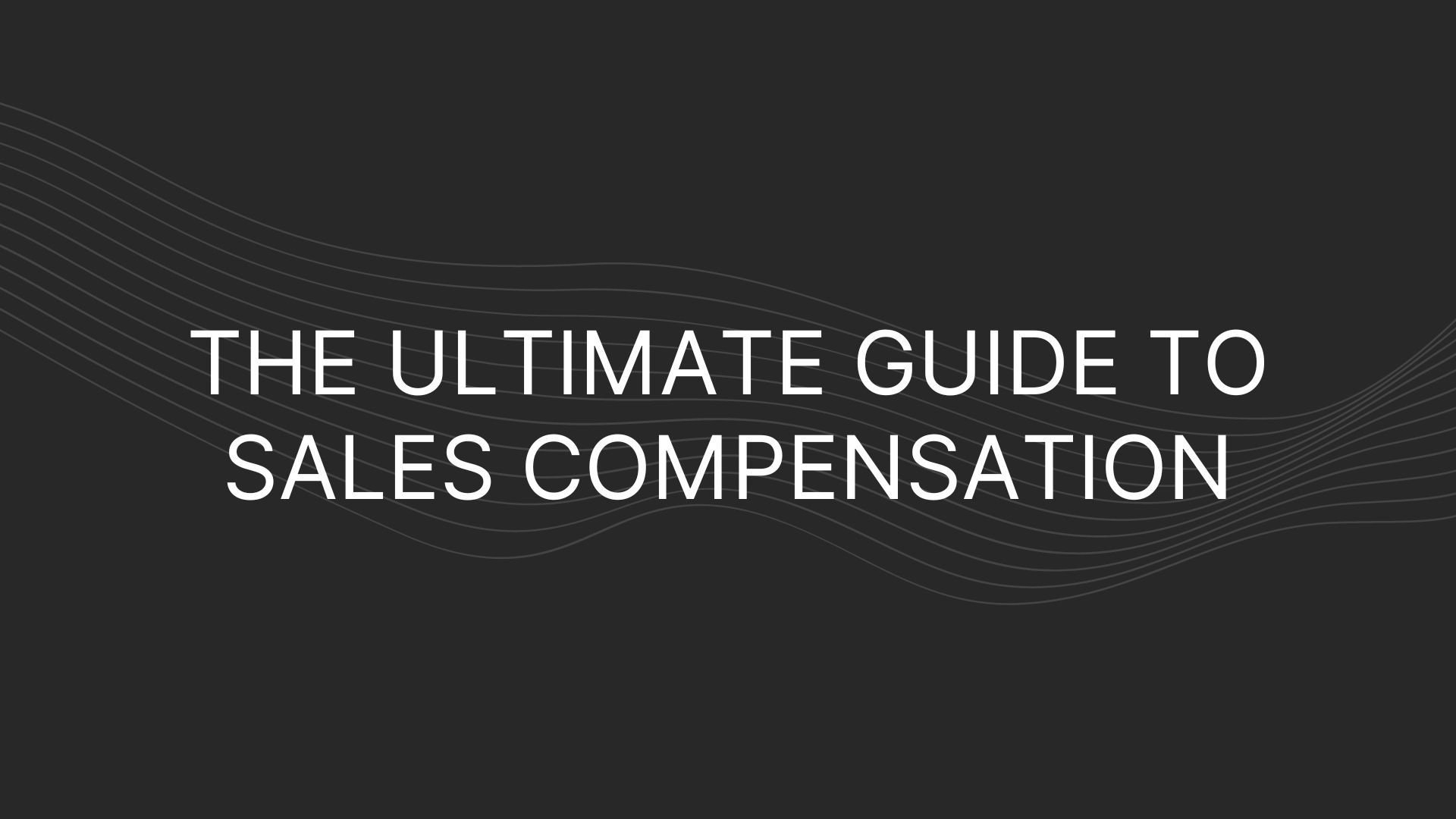Sales compensation is why many sales professionals get into the business – you can make a lot of money. Compensation based on sales performance and meeting quotas can push salespeople to change their behavior and work ethic because there is a benefit for them to do so.
To understand how compensation drives sales rep behavior, you have to understand the different compensation models and their benefits.
What Is Sales Compensation?
Sales compensation is what sales reps like Account Executives and SDRs are paid for their performance as dictated by the company they work for. A sales compensation model is one that includes multiple ways to earn money and be rewarded for the results you produce. When it comes to knowing how to hire salespeople, sales compensation plays a key part.
| Forms of Compensation | Explanation |
| Base salary | Paid to you regardless of your sales for the month. |
| Commission | Percentage of a sale received. Commission may be paid on top of a base salary. |
| Bonuses | Bonus for receiving certain sales quotas or goals. |
| Incentives | Additional perks based on sales or revenue the rep drove to the company. |
Many of the leading B2B companies require salespeople to make 4x – 5x of their compensation in sales for the company to remain viable.
Salespeople are like any other in the business world in that they’ll hit road bumps along the way. One month a person may have the highest sales and the next, they struggle to close every deal.
The right sales compensation model can:
- Reduce sales disruptions
- Motivate salespeople
- Keep performance levels high
Incentivizing higher sales, with a reflection in income, is one of the best motivators. Salespeople have to build deep relationships with clients and buyers, work long hours to nurture relationships and work hard to make sales.
Keeping a sales pipeline full is hard work, and compensating properly for this effort is what sales compensation is all about.
Why Does Sales Compensation Matter?
Charlie Munger’s famous quote, “Show me the incentive and I’ll show you the outcome,” remains one of the best in the sales world. The billionaire is the vice chairman of Berkshire Hathaway and knows what it takes to motivate sales teams.
The quote is simple: incentive attracts different people.
If someone enters sales based on the base salary alone, it doesn’t matter if they surpass last month’s sales figures or not. When you offer commission and bonuses, you’ll attract salespeople who:
- Remain motivated. Driving sales and exceeding expectations without acknowledgment and financial benefit is de-motivational. Sales compensation can motivate the workforce, allowing them to set goals and measure them through the reward that they receive. The individuals who are financially motivated will do everything they can to increase sales.
- Work towards the same goal. Compensation aligns with the goal of the salesperson and the company. You can help keep everyone on the sales team working towards the same goal by offering fair compensation.
If your goal is to expand into new markets, the right compensation can help all employees work towards entering the market with strong sales.
You’ll also find that the right compensation model:
- Attracts employees willing to put the hard work and effort into filling a sales pipeline
- Leads to retaining top talent
Base salaries and commission structures are two of the main factors that lead to continued business growth.
A business’s revenue and growth targets are tied to salespeople and the work ethic that they bring to the company. The right sales compensation structure can also help your business drive critical, meaningful behavior in your sales team.
How Sales Compensation Can Drive Behavior
Businesses can drive the behavior of their team when there’s sufficient motivation: i.e. money. Designing a compensation plan (more on that below) will help companies drive salespeople to try and receive goal-oriented bonuses.
For example:
- Offer a bonus any time the salesperson gets a client to pay via ACH rather than credit. Companies will save on fees and improve their profit margins with ACH. Even if you offer a 1% sales commission bonus, you’ll still be saving significant money in fees.
- Want salespeople to push for multi-year contracts? Offer a bonus every time that the employee lands a multi-year contract.
- Discounting costs your business money, even if it is a prime way to generate sales. Offer Account Executives an incentive to reduce the number of discounts they offer.
- Qualified meetings are more valuable than just any meeting. Push SDRs to book these highly qualified meetings by tying compensation to them.
Driving the desired behavior in your sales team will require you to have a thorough, goal- and objective-based plan in place.
How To Create a Sales Compensation Plan
Your goals and objectives must be known and outlined prior to making a sales compensation plan. A plan must align with the company’s goals if you want it to drive key behaviors and help you reach growth goals.
A plan must provide:
- Competitive compensation to attract the right level of talent
- Motivation for salespeople to keep pushing boundaries and increase sales
- Goal-oriented incentives
- Clear communication so that sales reps know exactly what they earn and how they earn it
With these points in mind, your CRO or VP can begin creating a sales compensation plan by following the steps below:
1. Assign an Action and Outcome for Each Goal and Objective
Your goals and objectives are already in place, but you need to assign an action and/or outcome to each of these goals. For example:
- A salesperson sells a multi-year contract (this is the action) and the outcome is a 5% commission.
- A sales individual increases the LTV of a customer, and the outcome is a bonus for increasing this percentage by 10%, or a tiered compensation model can be followed
Business goals that align with the actions of a sales team will reinforce the behavior you desire in your team.
2. Add in OTE, Pay Mix and Quotas
Salespeople do better through compensation and incentive. You should spend time determining the on-target earnings in your industry. This figure helps you attract and retain talent, but it must be just right to avoid:
- Increasing acquisition costs
- Reducing overall profit margins
- De-motivating sales individuals
An OTE can be $100,000 with 70% as a base and 30% as a mix of commission and bonus options if quotas or targets are met. Your pay mix must be enticing and rewarding without the base pay being too high or low.
Quotas should also be evaluated during this step because they cannot be too difficult to reach or so easy that they’re not a challenge.
3. Compensation Payout
When will the employee receive their payout for reaching sales goals and objectives? If the payout is immediate, it is far more incentivizing than if it’s 90 days down the road. The right payout will depend on the industry you’re in and the company size.
Sales Compensation Best Practices
Industry best practices shed light on what the top salespeople in the industry expect from your compensation plan. You’ll want to:
- Review and set quota bars properly
- Create incentives that are worth the effort
- Offer job role incentives to include all sales stakeholders
- Allow for unlimited, uncapped potential to earn
- Raise the bar to push employees to be on their game
Compensation plans require a lot of due diligence and a fundamental understanding of what your sales team wants to achieve: higher earning potential. You need to do your due diligence, create incentives that inspire teams to work harder and allow for uncapped potential. Discussing with your CFO is critical.
If one salesperson wants to earn $10,000 a month extra in commission, you may want to find a way to accommodate this.
Compensation plans can also allow for healthy competition amongst salespeople who want to outdo everyone else and push their limits.
Sales Compensation Challenges for Businesses
Companies that follow best practices will also face sales compensation challenges that they must prepare to overcome. Your challenges are unique to your business and plan, but common ones include:
- Creating a plan that is too complicated and unclear
- Failing to monitor and update the plan
- Changes to the plan that you fail to communicate to your team
- Creating plans for multiple sales roles that cannot reach specific goals
- Rushing through your plan
- Building a plan that’s identical to the competition
- Failing to design a plan that is based on your goals and objectives
While these few points are common challenges in a sales compensation plan, there are more that you’ll need to overcome, such as setting the OTE properly.
Sales Compensation – OTE Explained
In sales, OTE stands for “On-Target Earnings,” and it refers to the total compensation sales reps can expect to earn if they reach their sales targets or quotas.
In most cases, OTE includes a combination of fixed (salary) and variable earnings, such as commissions, incentives or bonuses.
OTE may be capped or uncapped:
- With a capped OTE, there is a limit or cap on the sales rep’s earnings. Once that cap is reached, they won’t earn any additional incentives or compensation.
- With an uncapped OTE, there is no limit to how much a sales rep can earn. They can earn unlimited commissions or incentives.
Choosing between capped and uncapped OTE will depend on several factors, including industry norms, market conditions and sales strategies.
While an uncapped OTE will motivate sales reps, it will also present challenges and risks. Uncapped earnings structures must be carefully monitored to ensure it doesn’t damage the company’s financial health. Additionally, this type of structure may lead to an aggressive sales culture, as reps may feel pressure to exceed their targets.
Sales Compensation Planning Tools
Sales compensation plans can often be complex and challenging to track. That’s where sales planning tools come into play.
The right software will automate the accounting and administrative aspects of incentive and commission programs.
These tools often integrate with other sales tools, including:
- Sales analytics
- Sales performance management
- Sales gamification
Some tools may include QuotaPath, Performio, Spiff, CapitvateIQ.
When used properly, sales compensation planning tools can save organizations time and resources.
Different Types of Sales Compensation Models
There are many different types of sales compensation models, and each one has benefits and drawbacks. Some plans provide more of an incentive to over-perform than others, and what works for one business may not work well for another.
It’s important to weigh your options carefully to ensure that you’re motivating your team to put their best foot forward.
- Base Salary + Commission
The most common sales compensation model is base salary plus commission. In fact, about 48% of organizations use this sales model.
Sales reps are paid a base annual salary in addition to commission.
This type of pay structure has advantages. It provides financial security for sales reps, but it also gives them an incentive to sell.
Commission percentages are typically lower because sales reps are paid a base salary. Common ratios are:
- 60:40 (60% fixed and 40% variable)
- 75:25 (75% fixed and 25% variable)
- 70:30 (70% fixed and 30% variable)
With this pay structure, businesses benefit from having more predictable expenses, as there’s less variability with this compensation model.
- Base Salary + Bonus Compensation
A base salary plus bonus compensation structure works well when sales reps consistently meet their targets. Organizations benefit from having a high level of predictability when it comes to expenses, and sales reps still have an incentive to sell.
This type of compensation model may look something like this:
- $40,000 base salary and $20,000 bonus for selling X amount each year
While this compensation plan allows for better expense planning, it doesn’t give sales reps an incentive to over-perform.
- Commission Only
With a commission only pay structure, sales reps are paid based on their performance. The more sales they close, the more money they earn. On the other hand, if they make zero sales in a month, their earnings would be zero.
Sales reps aren’t paid a base salary. Instead, they are only paid when they close a sale. For this reason, sales reps are highly motivated to close as many deals as possible.
This compensation plan is high-risk for sales reps and generally low-risk for organizations. The biggest challenge is forecasting expenses, as commissions can vary greatly from one month to the next.
Commission percentages can vary greatly, but typically sit in the range of 5%-45%.
- Absolute Commission
With an absolute commission plan, sales reps are paid a base salary and a commission each time they reach a specific milestone or target.
For example, you may pay your sales reps $800 for each new customer they bring on, or they may earn 20% of cross-sell revenue.
This type of compensation plan is easy for sales reps to understand, and it motivates them to perform at their best.
- Gross Margin Commission
A gross margin commission structure pays reps based on the organization’s profit rather than sales. Products with higher gross margins will provide a higher commission.
One big advantage of this compensation plan is that it discourages discounting. It also encourages sales reps to focus on closing deals on your most profitable products which will make every sales leader happy.
- Straight-Line Commission
With a straight-line commission pay structure, sales reps are paid based on their performance. If a sales rep reaches 120% of their quota, they receive 120% of their commission. If they only reach 80% of their quota, they receive 80% of their commission.
Sales reps should be encouraged and incentivized to over-perform. Otherwise, under-performers may find little motivation to improve their performance.
- Relative Commission
A relative commission model is based on a predetermined target or quota. The target may be based on volume or revenue.
Sales reps that reach 100% of their quota will make their OTE, which can be either their base salary plus commission or just commission.
Sales Comp Final Words
Sales compensation is what motivates sales reps to close sales, but it’s important to plan your compensation model carefully and use the best practices. If you’re unsure, you can always chat with a B2B sales consultant to consider your options. Otherwise, your organization may struggle to manage expenses or sales reps may not have an incentive to perform at their best. With sales compensation figured out, you need to make sure you have the right sales interview questions too.



